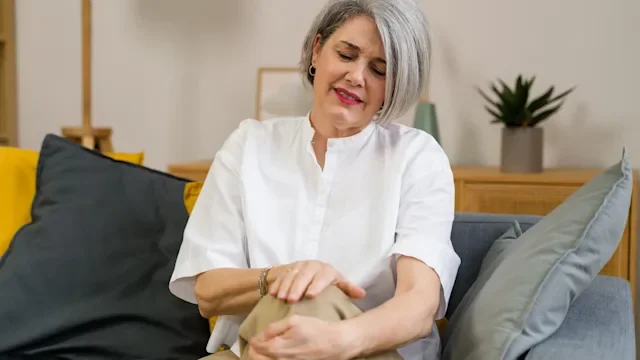Key takeaways:
Psoriasis is a common skin condition that can cause an itchy and painful rash on the feet. This can make walking difficult and uncomfortable.
People with foot psoriasis can also have psoriatic arthritis. This can cause swelling and pain in the joints of the foot.
Effective treatment for psoriasis usually includes a combination of creams, pills, and shots.
Identifying and avoiding certain triggers can help people manage psoriasis.
If you’ve developed an itchy or painful rash on your feet, you may have foot psoriasis. This common skin condition causes a rash that can affect any part of your skin, from your scalp to your toes. When it’s on your feet, it can be so itchy and painful that it’s difficult to walk.
Foot psoriasis can sometimes look like other common skin conditions, so it’s important to get the right diagnosis before starting treatment.
What does psoriasis on feet look like?
All types of psoriasis can affect the feet, but not all psoriasis on the feet looks the same. The rash can look different depending on which type of psoriasis you have.
Here are some common types of foot psoriasis, along with a description of how they look:
Plaque psoriasis causes thick, scaly plaques that are pink or red in lighter skin, and purple or brown in darker skin. This is the most common type, and it affects about 80% to 90% of people with psoriasis.
Palmoplantar psoriasis causes small, pus-filled blisters and deep cracks. It turns the soles of feet reddish or brownish.
Psoriatic nail disease is when psoriasis affects the nails. Nails look thick, yellow, broken, or crumbly, sometimes with tiny pits. Most people with psoriasis will experience nail changes at some point.
Psoriatic arthritis is when psoriasis causes inflammation in the joints. It can affect any joints in the body — including the feet. Psoriatic arthritis in the feet can cause swollen and painful toes, sometimes described as “sausage toes.” About 20% to 30% of people with psoriasis also have psoriatic arthritis.
What are symptoms of foot psoriasis?
Having psoriasis on your feet can make it hard to walk around. It can also negatively affect your quality of life. Here are some common symptoms caused by psoriasis on your feet:
Itching
Pain (especially when walking)
Dryness
Bleeding
Thickened skin
What causes psoriasis on the feet?
The exact cause of psoriasis on the feet — or anywhere else on the body — isn’t known. But, it’s likely a combination of different factors, including:
An overactive immune system
Your genes
Environmental triggers (like smoking)
Is it psoriasis, eczema, or athlete’s foot?
Psoriasis isn’t the only rash that shows up on the feet. Other common foot rashes include:
Athlete’s foot (tinea pedis), a fungal infection
Eczema, an itchy skin rash that can run in families.
Psoriasis from head to toe: Psoriasis doesn’t look the same everywhere. See how it can appear on your scalp, hands, feet, and more — and learn how to tell it apart from other skin rashes.
Living with psoriasis: Psoriasis changed her — but not her outlook. One woman shares how she manages flare-ups, cares for her skin, and finds strength in educating others.
Diet can affect psoriasis. What you eat can influence psoriasis. Some foods trigger flare-ups, while others — like veggies, fish, and nuts — can help calm inflammation.
How to soothe itching and flaking: From creams and ointments to shampoos, these top psoriasis treatments can calm flare-ups. Find out which options may work best for your skin.
Both athlete’s foot and eczema can look like psoriasis. So knowing how to tell the difference is an important step to getting the right treatment.
Keep in mind that you may need to see your dermatologist or other healthcare professional to get the right diagnosis.
Here are some key differences between foot psoriasis and other rashes.
| Condition | Where it appears | What it looks like | Symptoms |
|---|---|---|---|
| Psoriasis |
|
|
|
| Athlete’s foot |
|
|
|
| Eczema |
|
|
|
4 tips to manage foot psoriasis
Having psoriasis on the feet can be especially hard to deal with because people rely on their feet so much. And when it’s painful to just walk around, it can be really hard to focus on anything else.
Read more like this
Explore these related articles, suggested for readers like you.
The most effective way to manage foot psoriasis is through a combination of medication treatment, prevention, and everyday home remedies.
If you have foot psoriasis, here are four tips to try.
1. Find a treatment that works
This one may seem obvious, but it’s an important step. While there’s no cure for foot psoriasis, there are many treatments that can help you manage symptoms. Which one you use depends on a few different factors, like which treatments you’ve tried in the past, if you also have psoriatic arthritis, and your personal preferences.
Many people use more than one treatment at once. It can take some trial and error before you find the option that works best for you. Here are some options:
Topical treatments are applied directly to the skin. They include over-the-counter (OTC) and prescription-strength creams, like steroids, tazarotene, and calcipotriene.
Systemic treatments work throughout the whole body. They treat psoriasis that’s more severe, hasn’t responded to topical treatments, or is associated with psoriatic arthritis. These treatments come as pills (like methotrexate) or shots (like the biologics Humira and Stelara).
PUVA light therapy uses ultraviolet (UV) light along with psoralen. Psoralen is a medicated solution that you apply to your skin to sensitize it to UV light. Then, the feet are exposed to a specific wavelength of light for a few minutes. You need to have these treatments in your doctor’s office, usually 2 or 3 times a week for a few months.
2. Avoid psoriasis triggers
Certain triggers can worsen any type of psoriasis— and the same is true for foot psoriasis. So avoiding triggers is one important way to keep foot psoriasis from getting worse.
Psoriasis triggers aren’t the same for everyone though, and even the same trigger won’t affect two people in the same way. But, some common ones to try to avoid include:
Injuries to the skin, like scrapes or cuts
Certain medications, like beta blockers and nonsteroidal anti-inflammatory drugs (NSAIDS)
Infections, like strep throat
Emotional stress
3. Give your feet some TLC
If you have psoriasis on your feet, here are some home remedies you can try to make your symptoms more bearable:
Moisturize regularly with thick creams (especially ones with urea or salicylic acid).
Add oatmeal baths or Epsom salt baths to your routine.
Avoid harsh soaps.
Keep toenails trimmed.
4. Choose the right footwear
Wearing the right footwear is important. This can help minimize psoriasis symptoms and keep things from getting worse. Here are some suggestions to keep in mind:
Wear breathable socks made from natural fibers, like 100% cotton.
Wear comfortable shoes with enough room and good cushioning.
Avoid wearing flip-flops and/or going barefoot, which can expose feet to skin injuries.
If you have psoriatic arthritis in your feet, connect with a podiatrist to get the best-fitting shoes for you.
When to see a doctor about foot psoriasis
If you’re not sure what type of rash you have, or your rash isn’t getting any better, it may be time to see your primary care provider or a dermatologist. They can help confirm the diagnosis and help you find the best treatment option for you.
Frequently asked questions
Anyone who has psoriasis is at risk of developing foot psoriasis. In fact, studies show that about 15% of people with psoriasis will have some psoriasis on their hands and/or feet.
If you have foot psoriasis, look for socks that are breathable and made of natural fibers (like 100% cotton). These will be gentle on your skin and prevent skin irritation, which can worsen psoriasis.
Anyone who has psoriasis is at risk of developing foot psoriasis. In fact, studies show that about 15% of people with psoriasis will have some psoriasis on their hands and/or feet.
If you have foot psoriasis, look for socks that are breathable and made of natural fibers (like 100% cotton). These will be gentle on your skin and prevent skin irritation, which can worsen psoriasis.
The bottom line
Foot psoriasis is more common than many people think. And it can make even everyday activities, like walking, a challenge. Other rashes, like athlete’s foot and eczema, can look similar to psoriasis — but the treatment is very different. So the first step to feeling better is to get the right diagnosis.
Finding the best treatment for foot psoriasis may take a little trial and error. Combining medication with prevention strategies and home remedies can make living with foot psoriasis easier and more comfortable.

Why trust our experts?


References
DermNet. (n.d.). PUVA (photochemotherapy).
Fordyce, K. (2025). Nail psoriasis or nail fungus? National Psoriasis Foundation.
National Psoriasis Foundation. (2025). Palmoplantar psoriasis.
National Psoriasis Foundation. (2025). Plaque psoriasis.
National Psoriasis Foundation. (2025). Psoriasis on feet.


















